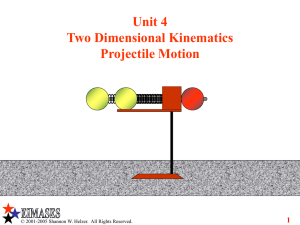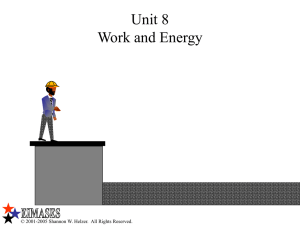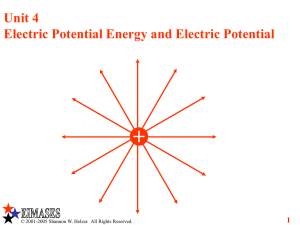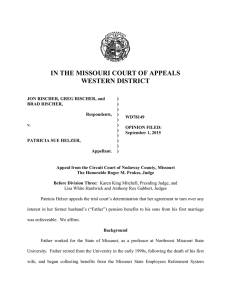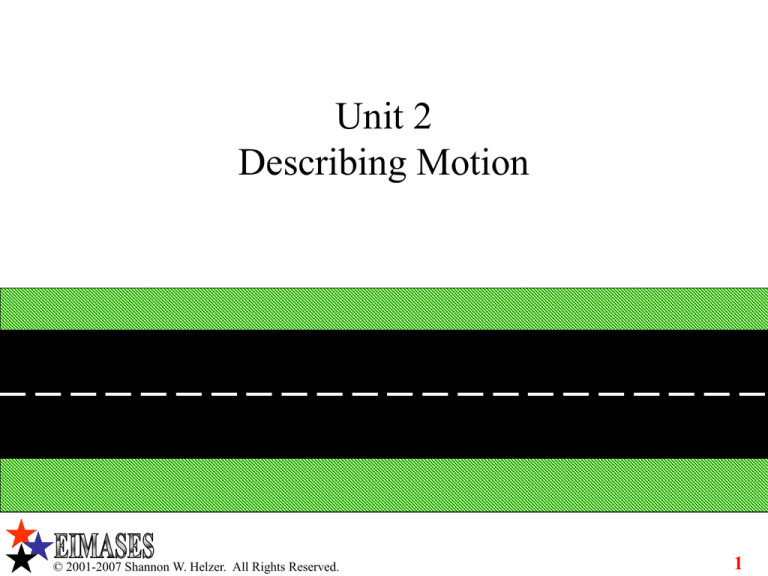
Unit 2
Describing Motion
© 2001-2007 Shannon W. Helzer. All Rights Reserved.
1
Units
What is a unit?
What are some common units that you deal with?
What does a unit do?
Give us a unit of volume. Mass. Speed.
© 2001-2007 Shannon W. Helzer. All Rights Reserved.
2
Speed
What is speed?
How fast something is going.
i.e. the speed limit
© 2001-2007 Shannon W. Helzer. All Rights Reserved.
3
Average Speed
What is average speed?
The total distance traveled divided by the time of travel.
A unit of length divided by a unit of time.
If x = distance & t = time, then the equation for average
speed, v, is
x2 x1 x
v
t2 t1 t
© 2001-2007 Shannon W. Helzer. All Rights Reserved.
4
Units of Speed
What are the units of speed?
A unit of length divided by a unit of time.
Some common units of speed are
© 2001-2007 Shannon W. Helzer. All Rights Reserved.
5
Unit Conversions
Here is a good format for doing unit conversions.
Convert 64 km/h to miles/s.
km 1m ile 1h 0.011 miles
64
s
h 1.609km 3600s
Practice conversions by verifying the results
given.
© 2001-2007 Shannon W. Helzer. All Rights Reserved.
6
Unit Conversions
What happens if you have one unit of speed and want to
determine the speed in different units?
You must convert.
Suppose you drove to Canada and were pulled over for
speeding by a mounty. She wrote you a ticket for going 64
km/h in a 60 km/h zone. You do not think that you were
speeding because you were only going 40 MPH. Were
you speeding?
40 MPH = 64 km/h: therefore, you were speeding!
© 2001-2007 Shannon W. Helzer. All Rights Reserved.
7
Instantaneous Speed
The rate at which distance is being covered at that instant
in time.
The average speed computed for a very, very short period
of time.
Speed v. Time
At what instant was
Speed km/h)
the speed the fastest?
What was the speed?
18 min @ 27 km/h.
Slowest? Speed?
30 min @ 4.5 km/h
30
20
10
10
© 2001-2007 Shannon W. Helzer. All Rights Reserved.
20
30
Time (min)
40
8
Instantaneous Speed
Suppose you raced your 4-wheeler
over a 20 mile long track.
If you completed the race in 40
minutes, then what was your
average speed?
30 mph.
Watch the animation below. Was
your speed at every instant equal
to your average speed?
Why or why not?
x2 x1 x
v
t2 t1 t
© 2001-2007 Shannon W. Helzer. All Rights Reserved.
9
Kinematics Examples
A MedFlight helicopter takes
off vertically with an upward
acceleration of 2.5 m/s2.
How fast is it going in 4.5 s?
How high up is it in 10.0 s?
v
a
t
© 2001-2007 Shannon W. Helzer. All Rights Reserved.
d
1 2
at
2
v at
10
Kinematics Examples
Dr. Physics had to make an emergency stop while riding his
motorcycle.
What was his final speed?
Initially, he was going 22.0 m/s.
If it took him 3.5 s to stop, then what was his acceleration?
a
© 2001-2007 Shannon W. Helzer. All Rights Reserved.
v
t
d
1 2
at
2
v at
11
Distance V. Time Graphs (WS 5 1-7)
Let us suppose that the graph to the right
Rise d d 2 d1
v
Run t
t 2 t1
© 2001-2007 Shannon W. Helzer. All Rights Reserved.
4.5
4
3.5
Distance (m)
represents a trip taken by a physics
student in a rocket powered wheel chair.
Answer the questions on your work sheet
using the graph provided.
Please note that the slope of a D v. T
graph is the velocity of the moving body.
Distance v. Tim e
3
2.5
2
1.5
1
0.5
0
0
2
4
6
8
10
Tim e (s)
12
Distance V. Time Graphs (WS 5 8-12)
Stewart Little ventures out from the
Rise d d 2 d1
v
Run t
t 2 t1
© 2001-2007 Shannon W. Helzer. All Rights Reserved.
Distance v. Tim e
450
400
350
Distance (km)
safety of the Little residence and takes
a very long trip in order to see his
girlbird Margalow.
His trip is graphed in the graph to the
right.
Answer the questions on your
worksheet based on the graph of
Stewart’s trip.
300
250
200
150
100
50
0
0
20
40
Tim e (hours)
13
Distance V. Time Graphs
A passenger train leaves station C and
© 2001-2007 Shannon W. Helzer. All Rights Reserved.
Distance v. Tim e
30
25
20
Distance (km)
travels East to station B.
It then travels West to station A before
returning to station C.
Answer the following questions using the
graph provided to the right.
What was the trains velocity between 0 and
20 minutes, at 1 hour, and 2 hours 36
minutes into the trip?
How far from station B is Station C?
How far from station A is Station B?
What was the train doing at the circled
point on the graph?
Is this trip a round trip? Why or why not?
15
10
0
5
0
-5 0
1
2
3
4
5
-10
Tim e (hr)
Rise d d 2 d1
v
Run t
t 2 t1
14
Velocity v. Time
The ship below is initially at rest.
Notice what happens when a positive
Rise v v2 v1
a
Run t t 2 t1
© 2001-2007 Shannon W. Helzer. All Rights Reserved.
10
Velocity (m/min)
acceleration acts upon the ship.
What do you suppose would happen if a
negative acceleration acted on the ship?
Calculate the acceleration acting on the
ship.
Velocity v. Time
5
0
0
5
10
15
20
-5
Time (min)
15
Velocity v. Time Graphs (WS 6 1-7)
The graph to the right depicts a short trip
Rise v v2 v1
a
Run t t 2 t1
© 2001-2007 Shannon W. Helzer. All Rights Reserved.
5
Velocity (m/s)
taken by MeanyBot.
Answer the questions on your work sheet
using the graph provided.
Please note that the slope of a V v. T
graph is the acceleration of the moving
body.
Velocity v. Time
4
3
2
1
0
0
4
8
12
Time (s)
16
Velocity v. Time Graphs
On this slide we will explore the effects of
Rise v v2 v1
a
Run t t 2 t1
© 2001-2007 Shannon W. Helzer. All Rights Reserved.
7.5
Velocity (m/min)
a negative velocity on the direction of
travel.
What is the velocity between 4 and 6
minutes, at 8 minutes, and at 14 minutes.
What is the acceleration between 4 and 6
minutes, at 8 minutes, and at 14 minutes.
Physically what is MeanyBot doing at the
point indicated on the graph?
Velocity v. Time
2.5
0
10
20
-2.5
-7.5
Time (min)
17
This presentation was brought to you by
Where we are committed to Excellence
In Mathematics And Science
Educational Services.
© 2001-2007 Shannon W. Helzer. All Rights Reserved.
18



